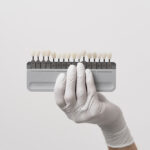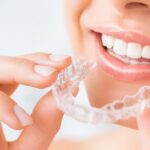What you will find in this article:
- When is it necessary to wear teeth?
- The advantages of dental contact lenses
- Post-application care
- Application Procedure
- Renew your smile with Dental Contact Lenses at OdontoLiuzzi
There are many myths spread today related to the aesthetic procedures necessary to achieve a perfect smile. Some people, for example, believe that to apply dental contact lenses it is necessary to significantly wear down the teeth, while others believe that this procedure is always painful and irreversible.
These misconceptions can generate unnecessary fears in those looking to improve the appearance of their teeth in a safe and effective way. The reality is that each case is unique and treatment must be personalized according to each patient's specific condition. The best professional to make this diagnosis is your dentist.
Not all aesthetic procedures require significant wear on teeth, and modern technologies have allowed interventions to be less and less invasive. Today, let's together demystify this information that teeth need to be worn down to apply dental contact lenses, learning a little better about the procedure and discovering all its advantages.
When is it necessary to wear teeth?
Teeth wear for the application of dental contact lenses depends mainly on the positioning and condition of the patient's teeth. In cases where the teeth are aligned and in good condition, wear may be minimal or even non-existent.
This is due to the fact that dental contact lenses are extremely thin, with thicknesses ranging from 0.2 to 0.5 millimeters. In these cases, the dentist can apply the lenses directly to the surface of the tooth, preserving the natural tooth structure as much as possible.
However, in situations where there is a need to correct misalignments, gaps or other more pronounced imperfections, light wear may be necessary to ensure that the lenses fit properly. This wear aims to create a uniform surface and ensure perfect adhesion of the lenses.
Even in these cases, the wear is much less invasive than that required for other restorations, such as full crowns, which involve significant wear on the tooth. The conservative approach to dental contact lenses allows for superior aesthetics with less intervention, providing an effective and minimally invasive solution for smile improvement.
The advantages of dental contact lenses
Dental contact lenses have stood out as one of the most sought after options for those who want to improve the aesthetics of their smile effectively and in a non-invasive way. This procedure not only offers a high-quality aesthetic solution, but also preserves the health and integrity of natural teeth.
Let's highlight some of the main advantages of dental contact lenses, highlighting why they are a popular choice among patients and dentists.
Natural aesthetics
Dental contact lenses are made from materials that mimic the appearance of natural teeth, including their translucency and shine. This allows them to harmoniously integrate into the smile, offering an aesthetic solution that is almost imperceptible. Unlike other dental restorations, dental veneers can provide a natural aesthetic without compromising the structure of the underlying teeth, maintaining the original appearance of the teeth while correcting imperfections.
Minimally invasive
The application of dental veneers generally requires little or no wear on your natural teeth. This means that the original structure of the teeth is well preserved, minimizing any negative impact on long-term dental health. This procedure is ideal for patients who want to improve the appearance of their teeth without the need for more invasive interventions such as crowns or veneers that require significant removal of tooth enamel.
Durability
With proper care, dental veneers can last 10 to 20 years. They are made from durable materials such as porcelain or high-strength ceramic, which are less susceptible to stains and wear compared to natural teeth. This ensures that patients can enjoy a beautiful, functional smile for many years, as long as they follow the maintenance and care recommendations provided by their dentist.
Correction of imperfections
Dental veneers are effective in correcting various dental imperfections, including stains, small cracks, slight misalignments and gaps between teeth. They offer a comprehensive solution to many aesthetic problems, allowing patients to significantly improve the appearance of their smiles with a single treatment. This versatility makes dental veneers a popular option for those seeking a complete aesthetic transformation with a simple and effective procedure.
Read too:
>>>> How long do dental contact lenses last?
Post-application care
Dental contact lenses are known for their durability, as long as they are well cared for. Some important precautions include:
- Proper oral hygiene: regular brushing and flossing to prevent plaque buildup.
- Avoid applying excessive force: Do not use your teeth to open packages or bite hard objects, which can damage the lenses.
- Regular dentist appointments: maintain regular visits to the dentist for evaluation and maintenance of lenses.
Application Procedure
The process of applying dental contact lenses is meticulous and involves several steps to ensure a precise and aesthetic result. First, the dentist performs a detailed assessment of the patient's oral health, discussing expectations and treatment possibilities. If necessary, slight tooth grinding can be done to create a suitable surface for lens adhesion.
Next, an impression of the teeth is taken, which will be used to make custom lenses in a specialized laboratory. After making the lenses, the dentist performs a test to check the fit and color of the lenses, ensuring that they integrate harmoniously with the patient's smile.
Once approved, the lenses are permanently cemented to the teeth with a special adhesive. This procedure is carried out with extreme precision to ensure that there are no spaces between the lens and the tooth, preventing future problems such as infiltrations.
Finally, the dentist makes the final adjustments, ensuring that the patient's bite is comfortable and functional, providing an aesthetically pleasing and natural smile.
Renew your smile with Dental Contact Lenses at OdontoLiuzzi
A OdontoLiuzzi is the ideal choice for you who want to place dental contact lenses in Rio de Janeiro. Our clinic offers humanized care with a qualified and up-to-date team, in addition to using modern technologies to increase the precision and comfort of each treatment.
Our environment is designed to provide comfort and tranquility, ensuring a relaxing experience for our patients. At OdontoLiuzzi, dental contact lenses are applied in a minimally invasive way, preserving the structure of natural teeth and providing an aesthetically pleasing smile.
We offer solutions to correct stains, slight misalignments, gaps and small cracks, always focusing on natural and lasting aesthetics. Schedule your consultation and discover how we can transform your smile with quality and excellence.
Read too:
>>>> What is the difference between dental contact lenses and veneers?









 per
per